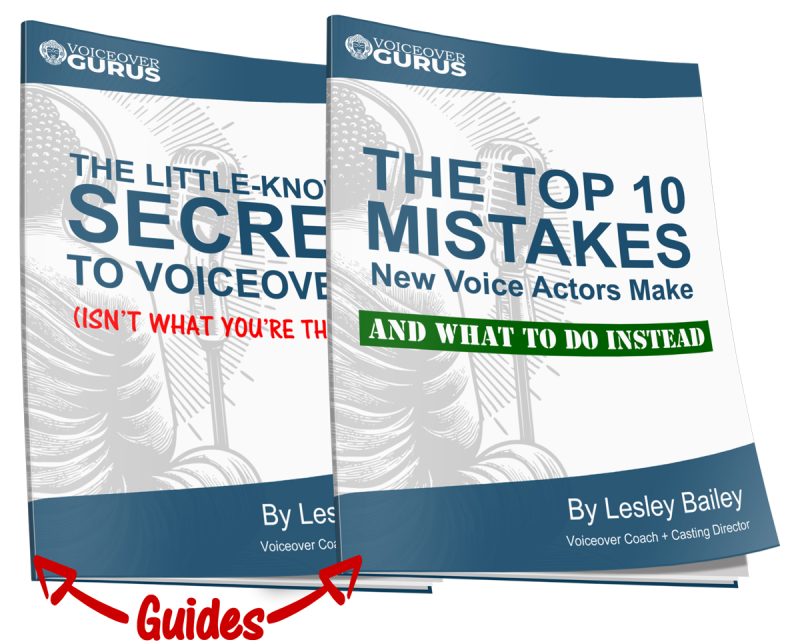I will gladly repeat this Voiceover Strategy concept till blue in the face – if you don’t understand what you’re saying on the deepest level (as deep as commercial copy can or will go!) then you are just READING. Remember when you wrote essays in school? Every time you put pen to paper or fingers to keyboard you had a point to make. You never wrote a single sentence without making a point. It’s kind of impossible, really. Look at the most basic sentence: Sally jumped. If, in the context of the story, you were already on the subject of this Sally gal and all her amazing abilities, then here the point is that she also knows how to jump. Your keyword is JUMPED. On the other hand, if you were talking about some of the other characters doing some jumping , then in this case your point is that now Sally did it. Keyword: Sally. Yes, so simple. But time and time again in voiceover training sessions I hear people reading. When I ask what they’re talking about it takes them way too long to answer. If they didn’t know right away, it meant they were reading. Announcing. Not understanding. It’s work, to identify what’s important in each sentence, especially since they’re someone else’s words. Today I will explain how to make the job of understanding your key words (aka the words to emphasize when you are conveying this information) a little bit easier. It starts with seeing the common link between the goal of most keywords, and the goal of most sentences….which is often the same thing.
We’re going to take a look at a bunch of commercials and break them down sentence by sentence, but first let’s take a look ….at what it is exactly we are looking for. As a voiceover coach, I take a look at commercial copy and instantly recognize the “sell.” I spent years in casting working with the advertising agencies and the production companies. I can recognize instantly what they’re trying to achieve now every time they create a commercial. Actually, let’s be safe and say 8 out of 10 ten times. The exceptions are those in which bragging about the product gets almost completely thrown out in the name of great comedy. But let’s work within the “more-often-than-not range as it is way more practical and you’ll get way more voiceover-audition bang for your buck. So, more often than not, the KEYWORDS in every sentence of a commercial voice over script will usually speak to the PAYOFF. To be more specific, the payoff is what is great about the product. It’s why YOU is not a keyword. Or WANT. As in: Sometimes you just want a great latte. The payoff here is great. But, great what? Great Latte. Great latte tells you what the reward is for getting this product and not someone else’s. YOU or WANT can’t do that. In most circumstances I will actually push for just the word great, but in this case it is the first line of the script and the concept of the latte hasn’t even been introduced yet, so it’s necessary. Either way, keep looking for the payoff in each sentence and you will have an easier time collecting your keywords. It’s not a hard fast rule, but like I said….more often than not. Let’s take a look at some scripts now and identify those keyword payoff hot spots.
Your journey is about staying ahead of the curve. Equal parts cruiser and sport-tourer, the Honda CTX1300 has a 1261cc V-4 that delivers endless torque for the city and top-end power and comfort for longer rides. Plus, it’s loaded with advanced features like available ABS, traction control, and Bluetooth audio. The CTX1300 is different for all the right reasons.
Ok, 1st sentence. What’s the payoff? Journey? No, you can take a journey in almost any vehicle. When you keep your brain on the payoff path, you will find it pretty quickly. It’s “ahead.” Curve might or might not need a bit of emphasis since that’s what “ahead” is describing, but to be concise with the payoff goal here, you hit on it with “ahead.” Other cars provide journeys and curves, but with this specific car you are AHEAD of the pack. You WIN with this one.
2nd sentence. Yikes. Do you start off at the top with “cruiser and sport-tourer”? Of course not. Now you’re getting the hang of this! Product name? Ok, a little bit, since it’s the first and only mention of it – but DO NOT get hung up on saying it too slowly, too loudly, or with any pausing before or after it. It is a mentionable in the middle of a natural conversation. So the payoff here is what it delivers, which also covers the beginning of the sentence we threw away importance-wise: Endless torque and top end power and comfort. Yes. Of course you want that right? In the next paragraph, emphasize your keywords as a voice actor with a writer’s mentality, which is to show, not tell. To tell would be to focus on the “loaded with advanced features” part. To SHOW would be to emphasize the actual features: ABS, traction control, Bluetooth audio. To SHOW is much more powerful. There’s support in it….evidence. Lastly, you focus on the word RIGHT. Different can be taken in a negative context in certain situations, reasons is empty with no other support words, but right is, well, right. When is RIGHT ever bad? Ok, ok, yes, when I’m trying to BE right in a “chat” with my husband. Moving on to the next VOICEOVER revelation.
Next script:
Introducing new Valspar Reserve interior and exterior paint with HydroChroma technology. Stain-resistant and fade-resistant. Now the colors you love stay the colors you love. Valspar Reserve. For whatever life throws at it.
Is introducing important? No, it’s a means to start talking. Is the product, Valspar Reserve important? Yes, but. Yes, you are mentioning it for the first time. But wait. We’ll get back to that. This sentence has a goal, and it’s to show you the payoff you get with this particular paint. Yes, it’s that HydroChroma technology, with the big bump on the HydroChroma, since they did capitalize it. Perhaps even trademarked it. The next sentence is perhaps the even more specific payoff/explanation for what HydroChroma does…..resists stains and fading. Emphasize STAIN-RESISTANT and then the word FADE, not that second resistant. They get it. Now let’s get back to the product name you have been itching to emphasize. It’s its own entire sentence this time. Nothing to compete with. Clearly, when the writer puts the product as its own sentence, they want it to be on a pedestal. Do it. Say it with pride and confidence, preferably in your lower inflection so you don’t sound like a cheesy car salesman. Finally we have the last sentence and I will say here the overwhelming word or me is WHATEVER. Funny word for payoff, but in context, it can withstand tomato sauce splatters, mud, WHATEVER. With the word whatever people get to fill in all the things that screw up their painted walls and see the problem vanish.
Here’s another:
Wrigley’s Extra Spearmint Gum. So refreshing it’s like your mouth’s on vacay.
Short but sweet. Perhaps catering to the younger crowd. The one that abbreviates words like vacation. That tells me instantly that the voiceover strategy or technique here is to cater to that crowd in a super cool but very casual way. Smile, smirk even, but keep it loose and conversational as opposed to overly bright and bubbl. I digress. We are here to talk keywords. Same rule here on the product as entire sentence line. It is all part of the product name so don’t throw away any of those 4 words, and say them as if this was the greatest and most important gum ever. Without raising your volume. Volume is one of the biggest voiceover mistakes around. People use it in replacement of all sorts of voiceover techniques like inflection or emphasis as a tool to express an emotion. Don’t cheat. Always see if there is a more authentic way to express that excitement, sarcasm, sincerity, or intelligence other than with volume – especially RAISING your volume. No one wants to be shouted at, unless they are listening to someone in danger or winning the lottery. Save your energy. Yes, digression. This second sentence is tricky. I’d go with REFRESHING and a slight hit on VACAY. They’re both positives, they’re both payoffs. They both make me want to get on a plane and go to a Caribbean island. Immediately. Now that’s good advertising.


 Hi! I’m Lesley Bailey. I’m an award-winning Casting Director, Voiceover Coach, Demo Producer, and Consultant with over 30 years “in the trenches”. I love helping voice actors bring scripts to life with authenticity and confidence.
Hi! I’m Lesley Bailey. I’m an award-winning Casting Director, Voiceover Coach, Demo Producer, and Consultant with over 30 years “in the trenches”. I love helping voice actors bring scripts to life with authenticity and confidence.